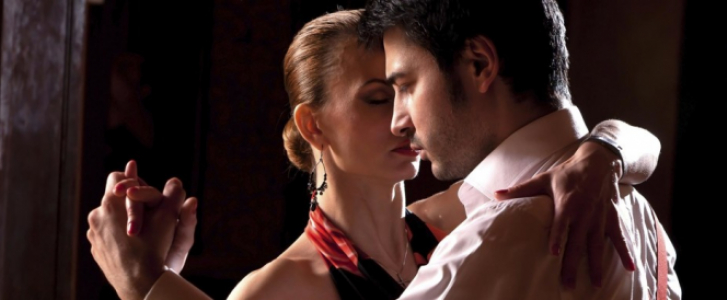Two variations of rhumba with opposing step patterns are danced around the world. American style rumba was imported to America by band directors like Emil Coleman and Don Aspiazú between 1913 and 1935. The film Rumba, released in 1935, brought the style to the attention of the general public. American style rhumba is taught in a box step, known for its slow-quick-quick pattern danced on the 1, 3, and 4 beats of 4-beat music. International style rhumba was developed in Europe by Monsieur Pierre after he compared the established American style with contemporary Cuban dancers. International style is taught in a quick-quick-slow pattern danced on the 2, 3, and 4 beats of 4 beat music, similar in step and motion to the cha-cha-cha. Both styles were canonized in 1955.
INTERNATIONAL STYLE
Rhumba is one of the ballroom dances which occurs in social dance and in international competitions. Of the five competitive international Latin dances (pasodoble, samba, cha-cha-cha, jive, and rumba), it is the slowest. This ballroom rumba was derived from a Cuban rhythm and dance called the bolero-son; the international style was derived from studies of dance in Cuba in the pre-revolutionary period.
The modern international style of dancing the rumba derives from studies made by dance teacher Monsieur Pierre (Pierre Zurcher-Margolle), who partnered Doris Lavelle. Pierre, then from London, visited Cuba in 1947, 1951, and 1953 to find out how and what Cubans were dancing at the time.
The international ballroom rumba is a slower dance of about 120 beats per minute which corresponds, both in music and in dance, to what the Cubans of an older generation called the bolero-son. It is easy to see why, for ease of reference and for marketing, rhumba is a better name, however inaccurate; it is the same kind of reason that led later on to the use of salsa as an overall term for popular music of Cuban origin.
All social dances in Cuba involve a hip-sway over the standing leg and, though this is scarcely noticeable in fast salsa, it is more pronounced in the slow ballroom rumba. In general, steps are kept compact and the dance is danced generally without any rise and fall. This style is authentic, as is the use of free arms in various figures. The basic figures derive from dance moves observed in Havana in the pre-revolutionary period, and have developed their own life since then. Competition figures are often complex, and this is where competition dance separates from social dance. Details can be obtained from the syllabuses of dance teaching organizations and from standard texts.
source: wikipedia
